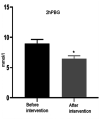Adverse effects of gestational diabetes-related risk factors on pregnancy outcomes and intervention measures
- PMID: 32855709
- PMCID: PMC7444321
- DOI: 10.3892/etm.2020.9050
Adverse effects of gestational diabetes-related risk factors on pregnancy outcomes and intervention measures
Abstract
This study was designed to investigate the risk factors of gestational diabetes mellitus (GDM), analyze its adverse effects on pregnancy outcomes and propose corresponding interventions. From January 2017 to December 2018, 378 GDM patients (GDM group) awaiting delivery in Weifang People's hospital were selected. At the same time, 200 pregnant women with normal blood glucose (NGT) were randomly selected as the control group. According to general and clinical data, the univariate and multivariate logistic regression analyses were used to screen the risk factors for GDM. The pregnancy outcomes of the two groups were calculated and corresponding intervention measures were proposed to provide a basis for the comprehensive prevention and treatment of gestational diabetes. Multivariate logistic regression analysis showed that age, pre-pregnancy body mass index (BMI), family history of diabetes, 2 h postprandial blood glucose (2hPBG), and glycated hemoglobin (HbA1c) were independent risk factors for GDM (P<0.05). The incidence of dystocia and cesarean section, abnormal amniotic fluid, premature rupture of membranes, and pathological pregnancy in the GDM group were significantly higher than those in the normal control group (P<0.01). The probability of fetal distress, macrosomia, small for date infants, and preterm infants in the GDM group was significantly higher than those in the normal control group (P<0.01). The 2hPBG and HbA1c in the GDM group after the intervention were significantly lower than those before intervention (P<0.05). The age of pregnant women and family history of diabetes play important roles in the presence and progression of GDM. Therefore, pregnant women should pay close attention to the relevant risk factors that trigger GDM, in the screening and prevention of GDM during pregnancy, reduce and prevent the presence of GDM to ensure the safety of mothers and infants.
Keywords: gestational diabetes; intervention measures; pregnancy outcomes; risk factors.
Copyright © 2020, Spandidos Publications.
Figures
References
-
- Crowther CA, Hiller JE, Moss JR, McPhee AJ, Jeffries WS, Robinson JS. Effect of treatment of gestational diabetes mellitus on pregnancy outcomes. N Engl J Med. 2005;352:2477–2486. doi: 10.1056/NEJMoa042973. Australian Carbohydrate Intolerance Study in Pregnant Women (ACHOIS) Trial Group. - DOI - PubMed
LinkOut - more resources
Full Text Sources
Medical


